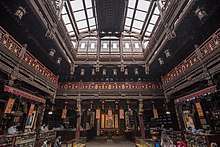Hu Qing Yu Tang
Hu Qingyu Tang (simplified Chinese: 胡庆余堂; traditional Chinese: 胡慶余堂; pinyin: Hú Qìngyú Táng) is a historically significant Chinese pharmaceutical company. It is as well known as a Tongrentang in Beijing.

Foundation
It was founded by Hu Xueyan with the south architectural style in 1874, located at 95 Dajing Lane (大井巷) alongside West Lake in Hangzhou, Zhejiang Province. The drugstore opened in 1878 at a cost of more than 200 thousand taels and operated on the principle of Taiping Huimin and the Bureau agents (太平惠民和剂局方). It made more than four hundred types of drug by collecting secret prescriptions, proved recipes and combining clinical practice.[1]
Development
Hu Qing Yu Tang has become the only Chinese medicine museum. In 1988, it became a national key cultural relics protection unit.[2] There are five parts:
- The exhibition hall, which introduces celebrities in Chinese medicine history, the origin of medicine, the development of pharmaceutics, the exchanges of China and foreign countries in medicine and the contributions of Zhejiang Province in the development of medicine.
- Chinese medicine manual mill hall, where experienced pharmaceutical workers show visitors traditional pharmaceutical process and visitors can experience by themselves.
- Patient room of traditional Chinese medicine health care
- The hall of medicated food
- Business lobby, where visitors can use the pharmaceutical tools and buy Chinese drugs.[3][4]
Hu Qing Yu Tang participated in World Leisure Expo for a healthy life in September, 2011.[5]
References
- Building Volume of The Series of Hangzhou Time-Honored Brand 杭州老字号系列丛书之建筑篇 author: Zhong Xiangping(仲向平) published by Zhejiang University Press in 2007 P02 ISBN 978-7-308-05360-0
- http://www.cctv.com/program/xwddk/20060602/103779.shtml
- http://news.xinhuanet.com/mrdx/2009-07/04/content_11651065.htm
- "Archived copy". Archived from the original on 2011-12-26. Retrieved 2011-12-21.CS1 maint: archived copy as title (link)
- http://europe.chinadaily.com.cn/travel/2011-09/19/content_13732157.htm